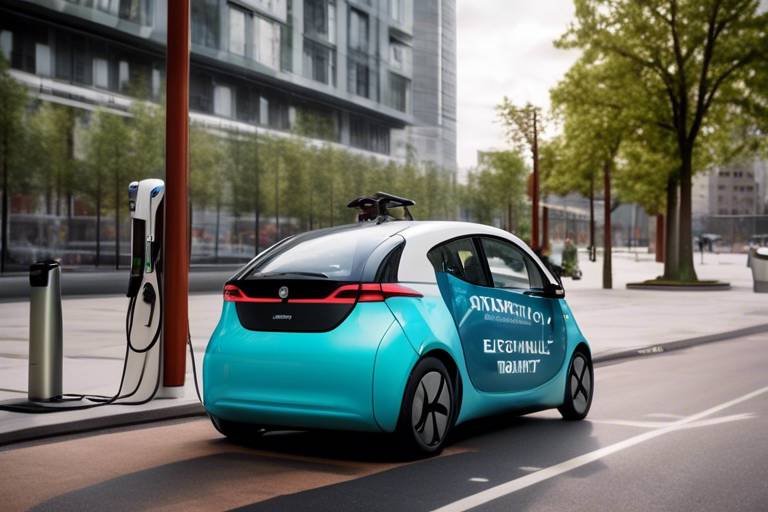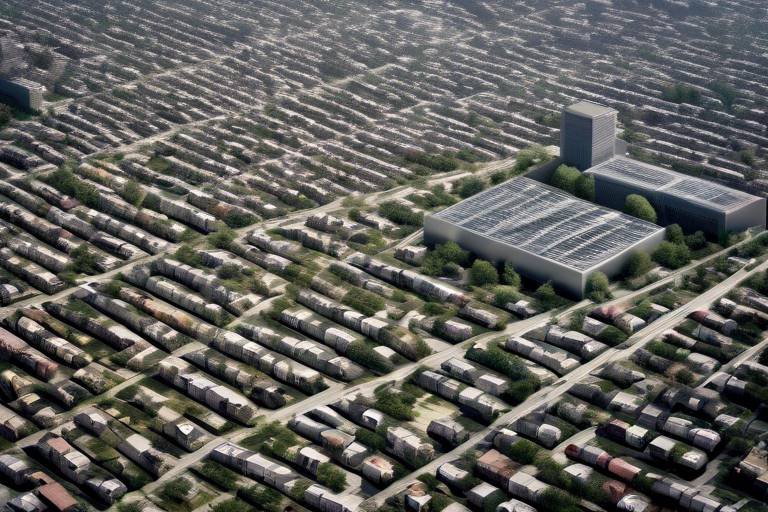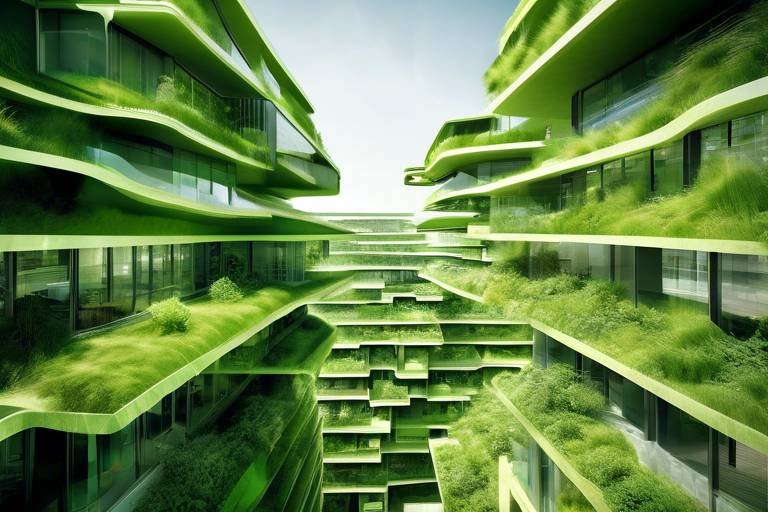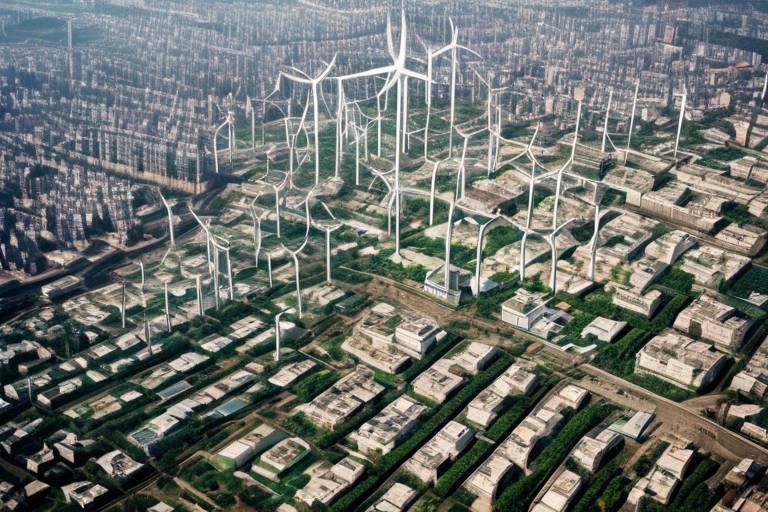Can CO2 Absorbing Concrete Reduce Urban Pollution?
As urban areas continue to expand and populations grow, the challenge of managing urban pollution becomes increasingly critical. One innovative solution that has emerged in recent years is CO2 absorbing concrete. This remarkable material not only serves the traditional functions of concrete but also has the ability to absorb carbon dioxide from the atmosphere. Imagine a city where buildings and pavements actively work to cleanse the air, contributing to a healthier environment. Could this be the future of urban development? In this article, we will explore how CO2 absorbing concrete works, its potential benefits, and the implications for sustainable urban living.
The concept of CO2 absorbing concrete is rooted in the understanding of chemical processes. When exposed to carbon dioxide, certain components within the concrete undergo a reaction that allows them to capture and store this greenhouse gas. This process, known as carbonation, not only contributes to the strength of the concrete but also plays a crucial role in reducing overall carbon emissions. By integrating this technology into urban infrastructure, cities can take a significant step towards combating climate change and improving air quality.
But how does this all translate into real-world benefits? The potential impact of CO2 absorbing concrete on urban pollution is profound. By reducing the amount of CO2 in the atmosphere, it can help mitigate the effects of climate change, which is an ongoing concern for cities around the globe. Moreover, as urban pollution is linked to various health issues, including respiratory diseases, improving air quality through innovative materials like CO2 absorbing concrete could lead to healthier communities. Imagine walking through a bustling city and feeling the difference in air quality—fresher, cleaner, and more invigorating. This is the promise of CO2 absorbing concrete.
Furthermore, the benefits of this technology extend beyond environmental health. The economic implications are equally significant. By reducing pollution and potentially lowering healthcare costs associated with pollution-related illnesses, cities could save substantial amounts of money. Additionally, the adoption of CO2 absorbing concrete may lead to new job opportunities in the green construction sector, stimulating local economies. It’s a win-win scenario, where urban areas can thrive both environmentally and economically.
However, while the prospects are bright, it’s essential to consider the challenges and limitations that CO2 absorbing concrete faces. Production costs can be higher than traditional concrete, which may deter some stakeholders from making the switch. Additionally, scaling up production to meet the demands of large urban projects poses another hurdle. It's crucial for researchers and industry leaders to collaborate and find solutions to these challenges, ensuring that this innovative material can be widely adopted.
In conclusion, CO2 absorbing concrete holds incredible potential for reducing urban pollution and promoting sustainable development. By integrating this technology into our cities, we can create healthier environments, stimulate economic growth, and take significant strides in the fight against climate change. As we look to the future, the question remains: will we embrace this innovative solution and pave the way for cleaner, greener urban landscapes?
- What is CO2 absorbing concrete? CO2 absorbing concrete is a type of concrete that can absorb carbon dioxide from the atmosphere, contributing to reduced greenhouse gas emissions.
- How does it work? The concrete undergoes a chemical reaction known as carbonation, which allows it to capture and store CO2.
- What are the benefits of using CO2 absorbing concrete? It helps improve air quality, reduces greenhouse gas emissions, and can lead to economic savings in healthcare and construction.
- Are there any challenges in using CO2 absorbing concrete? Yes, challenges include higher production costs and issues related to scaling up production for widespread use.

The Science Behind CO2 Absorbing Concrete
Understanding the intricate chemistry behind CO2 absorbing concrete is crucial for grasping its potential to revolutionize urban construction. At its core, this innovative material leverages a process called carbonation, where carbon dioxide from the atmosphere reacts with compounds in the concrete itself. This reaction not only helps to sequester CO2 but also enhances the durability of the concrete. Imagine concrete as a sponge, soaking up harmful gases while simultaneously becoming stronger over time!
The primary ingredients in CO2 absorbing concrete include traditional materials like cement, aggregates, and water, combined with additives that promote the carbonation process. One of the key components is calcium hydroxide, which is produced during the hydration of cement. When exposed to CO2, calcium hydroxide reacts to form calcium carbonate, effectively locking away carbon dioxide in a solid form. This transformation is not just a neat trick; it plays a significant role in reducing the overall carbon footprint of concrete, which is traditionally a major contributor to greenhouse gas emissions.
To illustrate the effectiveness of this process, consider the following table that summarizes the chemical reactions involved:
| Process | Chemical Reaction | Outcome |
|---|---|---|
| Hydration of Cement | C3S + H2O → C-S-H + Ca(OH)2 | Produces calcium hydroxide |
| Carbonation | Ca(OH)2 + CO2 → CaCO3 + H2O | Sequesters CO2 as calcium carbonate |
This dual benefit of enhancing durability while capturing carbon makes CO2 absorbing concrete an exciting prospect for urban planners and environmentalists alike. However, the science doesn’t stop there. Researchers are continually exploring ways to optimize the composition of these concrete mixtures to maximize CO2 absorption rates. This includes experimenting with various additives and alternative materials, such as industrial by-products, which can further improve the sustainability of the concrete industry.
Moreover, the environmental impact of CO2 absorbing concrete extends beyond just the construction phase. As buildings and infrastructure made from this material age, they continue to absorb CO2 over their lifespan. This ongoing process can lead to significant reductions in atmospheric carbon levels, making it a vital tool in the fight against climate change. In essence, using CO2 absorbing concrete is like planting trees in the urban jungle—both contribute positively to our environment!

Benefits of CO2 Absorbing Concrete
The introduction of CO2 absorbing concrete marks a significant leap forward in sustainable construction practices. This innovative material is not just about building structures; it's about creating a healthier environment. Imagine walking through a city where the air is cleaner, and the buildings are actively working to combat pollution. This is the promise that CO2 absorbing concrete holds. By integrating this technology into urban planning, we can significantly reduce our carbon footprint and improve the quality of life for residents.
One of the most compelling advantages of CO2 absorbing concrete is its ability to reduce greenhouse gas emissions. Traditional concrete is known for its high carbon emissions during production. However, CO2 absorbing concrete utilizes a chemical process that allows it to capture carbon dioxide from the atmosphere. This means that not only does it prevent additional CO2 from being released, but it also actively removes existing CO2, thus playing a crucial role in tackling climate change.
Moreover, the use of CO2 absorbing concrete can lead to improved air quality. In urban environments, air pollution is a pressing issue, often leading to health problems for residents. The concrete works like a sponge, absorbing harmful pollutants and releasing cleaner air. Studies have shown that cities implementing this technology can see a noticeable decrease in particulate matter and other harmful emissions. Imagine the impact on public health if cities could lower their pollution levels just by using a different type of concrete!
Another significant benefit is the potential for long-term cost savings. While the initial investment in CO2 absorbing concrete may be higher than traditional materials, the long-term savings can be substantial. This concrete can extend the lifespan of structures due to its enhanced durability and lower maintenance needs. Additionally, the reduction in health care costs associated with improved air quality can lead to economic benefits for municipalities. In essence, investing in CO2 absorbing concrete is not just an environmental decision; it's a financially savvy one as well.
Furthermore, the use of this innovative material aligns with the growing trend toward sustainable urban development. As cities strive to meet sustainability goals, incorporating CO2 absorbing concrete can help meet these targets while enhancing the overall aesthetic and functionality of urban spaces. The incorporation of green technologies in construction is becoming a priority, and CO2 absorbing concrete fits perfectly into this vision.
In summary, the benefits of CO2 absorbing concrete are multifaceted, making it an attractive option for urban planners and builders alike. From reducing greenhouse gas emissions and improving air quality to offering long-term cost savings and supporting sustainable development, this innovative material is paving the way for a cleaner, healthier future. As we look towards a more sustainable urban landscape, the adoption of CO2 absorbing concrete could be a game changer.
- What is CO2 absorbing concrete?
CO2 absorbing concrete is a type of concrete that captures carbon dioxide from the atmosphere during its curing process, helping to reduce overall greenhouse gas emissions. - How does it improve air quality?
By absorbing CO2 and other pollutants, this concrete actively cleans the air, leading to healthier living conditions in urban environments. - Is it more expensive than traditional concrete?
While the upfront costs may be higher, the long-term savings in maintenance and health care can offset these initial expenses. - Can it be used in all types of construction?
Yes, CO2 absorbing concrete can be utilized in various construction projects, from residential buildings to large-scale infrastructure.

Impact on Air Quality
The impact of CO2 absorbing concrete on urban air quality is nothing short of revolutionary. Imagine walking through a bustling city, surrounded by towering buildings that not only serve as homes and offices but also act as silent guardians against pollution. This innovative material has the potential to transform our urban landscapes into healthier environments. How does it work? Well, when CO2 absorbing concrete is exposed to the atmosphere, it engages in a chemical reaction that allows it to capture carbon dioxide from the air. This process not only reduces the amount of CO2—a major greenhouse gas—present in the atmosphere but also contributes to the formation of calcium carbonate, a stable and harmless compound.
As cities continue to grow and urbanization intensifies, air quality has become a pressing concern. Traditional construction materials often contribute to pollution, but CO2 absorbing concrete offers a compelling alternative. By integrating this eco-friendly material into urban infrastructure, cities can significantly reduce the levels of harmful pollutants such as nitrogen oxides (NOx) and particulate matter (PM). These pollutants are notorious for their adverse effects on human health, leading to respiratory problems, cardiovascular diseases, and even premature death. The use of CO2 absorbing concrete can mitigate these risks, leading to a cleaner and safer urban atmosphere.
Moreover, the benefits extend beyond just capturing CO2. The presence of this concrete in urban settings can enhance the overall aesthetic of the city while promoting biodiversity. For instance, when used in parks or green spaces, CO2 absorbing concrete can support vegetation growth by improving soil quality through its mineral content. This, in turn, helps create more green areas that act as natural air filters, further improving air quality.
To illustrate the potential improvements in air quality with the adoption of CO2 absorbing concrete, consider the following table that summarizes key pollutants and their sources:
| Pollutant | Source | Impact on Health |
|---|---|---|
| Nitrogen Oxides (NOx) | Vehicle emissions, industrial processes | Respiratory issues, aggravation of asthma |
| Particulate Matter (PM) | Construction, combustion, and industrial activities | Cardiovascular diseases, lung cancer |
| Carbon Dioxide (CO2) | Burning fossil fuels, deforestation | Climate change, indirect health effects |
By replacing conventional concrete with CO2 absorbing alternatives in urban construction, cities can expect a marked improvement in air quality. The reduction of pollutants not only benefits the environment but also enhances the quality of life for residents. Cleaner air leads to healthier populations, and healthier populations contribute to more vibrant communities.
So, the next time you think about the concrete jungle of a city, remember that it doesn’t have to be a concrete nightmare. With the right materials, we can pave the way for a brighter, cleaner future. Imagine the possibilities: children playing in parks with fresh air, families enjoying outdoor spaces without fear of pollution, and cities that prioritize the health of their residents. The implementation of CO2 absorbing concrete is a step toward realizing this vision.

Case Studies of Successful Implementation
When it comes to groundbreaking innovations like CO2 absorbing concrete, real-world examples can speak volumes about their effectiveness and potential. One of the most notable case studies is found in the city of Los Angeles, where a pilot project utilized this innovative material in the construction of a new parking structure. The project aimed not only to provide additional parking spaces but also to tackle the city's notorious air quality issues. Over the course of the project, it was reported that the CO2 absorbing concrete was able to sequester approximately 24 tons of CO2 during its curing process. This is akin to removing the emissions from about 5 vehicles off the road for an entire year!
Another impressive case study is in Italy, where a major infrastructure project incorporated CO2 absorbing concrete into the construction of a new highway. The Italian government was keen on reducing the carbon footprint of its roadways, and this initiative proved to be a game changer. Not only did the concrete significantly reduce carbon emissions during its lifecycle, but it also resulted in 30% less energy consumption compared to traditional concrete. The success of this project has paved the way for further research and development, with plans to implement CO2 absorbing concrete in future road projects across Europe.
In Singapore, the use of CO2 absorbing concrete was part of an ambitious urban renewal project. This initiative focused on transforming older neighborhoods into greener, more sustainable living spaces. The results were staggering; the new concrete structures not only enhanced the aesthetic appeal of the area but also contributed to a measurable reduction in urban heat and improved air quality. Residents reported feeling healthier and more vibrant, with fewer respiratory issues, showcasing the profound impact that such materials can have on community health.
To better understand the effectiveness of CO2 absorbing concrete, we can look at the following table that summarizes key metrics from these case studies:
| Location | Project Type | CO2 Sequestered (Tons) | Additional Benefits |
|---|---|---|---|
| Los Angeles | Parking Structure | 24 | Reduced vehicle emissions equivalent |
| Italy | Highway Construction | Not specified | 30% less energy consumption |
| Singapore | Urban Renewal | Not specified | Improved air quality and health |
These case studies highlight the transformative potential of CO2 absorbing concrete. They not only demonstrate the material's ability to sequester carbon but also illustrate the broader benefits that come with its use in urban settings. As cities around the world grapple with pollution and climate change, the successful implementation of CO2 absorbing concrete could serve as a model for future construction projects. It’s a powerful reminder that innovation in materials can lead to healthier, more sustainable urban environments.
1. What is CO2 absorbing concrete?
CO2 absorbing concrete is a type of eco-friendly concrete that captures carbon dioxide from the atmosphere during its curing process, thereby reducing greenhouse gas emissions.
2. How does CO2 absorbing concrete improve air quality?
By sequestering CO2, this concrete reduces the amount of carbon dioxide in the atmosphere, which can help mitigate climate change and improve overall air quality in urban areas.
3. Are there any successful examples of CO2 absorbing concrete in use?
Yes, cities like Los Angeles, Italy, and Singapore have implemented CO2 absorbing concrete in various projects, yielding positive results in terms of carbon sequestration and improved urban environments.
4. What are the economic implications of using CO2 absorbing concrete?
While the initial production costs may be higher, the long-term savings in terms of reduced emissions and improved public health can offset these costs, making it an economically viable option.
5. What challenges does CO2 absorbing concrete face?
Challenges include production costs, scalability, and the need for widespread adoption in the construction industry. However, ongoing research may help overcome these barriers.

Long-term Environmental Benefits
The implementation of CO2 absorbing concrete presents a multitude of long-term environmental benefits that extend well beyond mere pollution reduction. Imagine a world where our buildings not only serve as shelters but also actively contribute to the health of our planet. This innovative material has the potential to transform urban landscapes into green havens, creating a symbiotic relationship between infrastructure and nature.
One of the most significant advantages of CO2 absorbing concrete is its ability to sequester carbon dioxide over time. During its curing process, this unique concrete absorbs CO2 from the atmosphere, effectively reducing the concentration of this greenhouse gas. Studies suggest that for every ton of CO2 emitted during the production of traditional concrete, CO2 absorbing concrete can offset a substantial amount, creating a net positive effect on the environment. This characteristic not only helps combat climate change but also promotes a healthier atmosphere in urban areas.
Moreover, the use of CO2 absorbing concrete can lead to improved urban ecosystems. By incorporating this material into construction projects, cities can enhance their green spaces, which play a crucial role in supporting biodiversity. Urban environments often struggle with habitat loss, but with the integration of green infrastructure alongside CO2 absorbing concrete, we can create spaces that foster wildlife and plant growth. This not only beautifies cities but also contributes to the overall ecological balance.
Additionally, the long-term benefits of using CO2 absorbing concrete include reduced heat island effects. Urban areas are notorious for their heat retention, which exacerbates energy consumption and contributes to discomfort during hot weather. By utilizing this innovative concrete, cities can mitigate these effects, as the material's properties can help regulate temperatures. This leads to lower energy costs for cooling buildings, ultimately resulting in a more sustainable urban environment.
Incorporating CO2 absorbing concrete into urban planning also aligns with the goals of sustainable development. It reflects a proactive approach to addressing environmental challenges, setting a precedent for future construction practices. As cities continue to grow, the demand for sustainable building materials will only increase. Thus, investing in CO2 absorbing concrete can pave the way for a greener future, ensuring that urban development does not come at the expense of our planet.
In summary, the long-term environmental benefits of CO2 absorbing concrete are profound and far-reaching. By reducing carbon emissions, enhancing biodiversity, minimizing heat retention, and promoting sustainable development, this innovative material stands as a beacon of hope in the fight against urban pollution and climate change.
- What is CO2 absorbing concrete? CO2 absorbing concrete is a type of concrete that can capture and store carbon dioxide from the atmosphere during its curing process, helping to reduce greenhouse gas emissions.
- How does CO2 absorbing concrete improve air quality? By absorbing CO2, this concrete helps lower the levels of greenhouse gases in urban environments, which can lead to improved air quality and healthier living conditions.
- Are there any economic benefits to using CO2 absorbing concrete? Yes, while the initial costs might be higher, the long-term savings in energy costs and the potential for reduced carbon taxes can make it economically viable.
- What challenges does CO2 absorbing concrete face? The primary challenges include production costs, scalability issues, and the need for broader acceptance within the construction industry.

Economic Implications
The introduction of CO2 absorbing concrete into urban construction practices is not just an environmental boon; it also carries significant that could reshape the landscape of urban development. For cities grappling with the dual challenges of pollution and infrastructure costs, this innovative material presents a unique opportunity to achieve sustainability while also saving money in the long run. Imagine a city where buildings do more than just shelter residents; they actively work to improve air quality and reduce greenhouse gas emissions. Sounds like a dream, right? Well, this dream is closer to reality than you might think!
First and foremost, the use of CO2 absorbing concrete can lead to substantial cost savings over time. By integrating this technology into new construction projects, cities can reduce their reliance on traditional air purification systems, which often come with hefty operational costs. Instead of spending millions on filters and air scrubbers, urban planners can invest in materials that continuously work to clean the air. This shift could result in a significant decrease in municipal budgets dedicated to air quality management.
Moreover, the long-term benefits extend to public health as well. Improved air quality can lead to lower healthcare costs associated with respiratory illnesses and other pollution-related health issues. A healthier population means fewer sick days, increased productivity, and ultimately, a more robust economy. In fact, a study by the Environmental Protection Agency (EPA) suggests that for every dollar spent on air quality improvements, there could be a return of up to $30 in health benefits. This is a compelling argument for adopting CO2 absorbing concrete in urban planning.
However, it’s essential to consider the initial investment. The production of CO2 absorbing concrete can be more expensive than traditional concrete due to the advanced materials and processes involved. But, when viewed through the lens of long-term savings and environmental benefits, the initial costs may be justified. In a way, it’s like buying a high-efficiency appliance; the upfront cost is higher, but the savings on your energy bill over time make it worth it.
| Cost Comparison | Traditional Concrete | CO2 Absorbing Concrete |
|---|---|---|
| Initial Cost per Ton | $100 | $120 |
| Long-term Savings (10 years) | $0 | $500 |
| Healthcare Cost Savings | $0 | $300 |
As cities continue to expand, the demand for sustainable building materials will only increase. By adopting CO2 absorbing concrete, urban planners can position their cities as leaders in sustainability, attracting businesses and residents who prioritize environmental responsibility. This shift not only enhances the city's reputation but also opens up new avenues for economic growth. Think of it as a win-win situation: cleaner air and a thriving economy!
In conclusion, the economic implications of CO2 absorbing concrete are profound. While the initial costs may give some stakeholders pause, the long-term benefits—ranging from reduced healthcare expenses to enhanced urban livability—make a compelling case for its adoption. As we move toward a future where cities must balance growth with sustainability, CO2 absorbing concrete could be the key to achieving that delicate equilibrium.
- What is CO2 absorbing concrete? - It's a type of concrete that captures carbon dioxide from the atmosphere, helping to reduce pollution.
- How does it work? - The chemical processes involved allow the concrete to absorb CO2 over time, effectively cleaning the air.
- Is it more expensive than traditional concrete? - Yes, the initial costs are higher, but the long-term savings can justify the investment.
- What are the health benefits? - Improved air quality can lead to lower healthcare costs and a healthier population.
- Can it be scaled for widespread use? - While there are challenges, ongoing research and development are addressing these issues to make it more accessible.

Challenges and Limitations
While the concept of CO2 absorbing concrete is indeed revolutionary, it’s not without its challenges and limitations. One of the primary hurdles lies in the production costs associated with this innovative material. Traditional concrete is relatively cheap and widely available, but the process of creating CO2 absorbing concrete often involves specialized materials and techniques that can drive the price up significantly. This increase in cost can deter construction companies and urban planners who are working with tight budgets.
Moreover, the scalability of CO2 absorbing concrete presents another significant challenge. Currently, the production of this material is not as widespread as conventional concrete, which means that supply chains are not yet fully developed. For instance, while some companies have successfully created small batches of CO2 absorbing concrete, scaling this up to meet the demands of large-scale construction projects requires substantial investment in infrastructure and technology. Without a robust supply chain, it becomes difficult to integrate this eco-friendly option into mainstream construction practices.
Additionally, there is a lack of awareness and understanding among stakeholders, including builders, architects, and city planners. Many may be unaware of the benefits and potential applications of CO2 absorbing concrete. This knowledge gap can hinder its adoption, as stakeholders may stick with traditional materials that they are more familiar with. Education and outreach initiatives are crucial to inform the industry about the long-term advantages of using CO2 absorbing concrete.
Another limitation is the performance characteristics of CO2 absorbing concrete compared to traditional options. While it excels in absorbing carbon dioxide, there are concerns regarding its structural integrity and durability over time. Builders need to ensure that this new material meets the same safety and longevity standards as conventional concrete. Ongoing research and development are essential to address these concerns and improve the material's performance metrics.
In summary, while CO2 absorbing concrete offers exciting possibilities for reducing urban pollution, its widespread adoption is hindered by various factors. These include production costs, scalability issues, lack of awareness, and concerns about performance. Overcoming these challenges will require collaboration among industry stakeholders, ongoing research, and innovative solutions to make CO2 absorbing concrete a staple in sustainable urban development.
- What is CO2 absorbing concrete?
CO2 absorbing concrete is a type of concrete that is designed to absorb carbon dioxide from the atmosphere, helping to reduce greenhouse gas emissions and improve air quality.
- How does CO2 absorbing concrete work?
This material utilizes specific chemical processes to capture and store CO2, effectively converting it into a solid mineral form within the concrete.
- What are the benefits of using CO2 absorbing concrete?
Benefits include reduced greenhouse gas emissions, improved air quality, and potential long-term environmental advantages such as contributing to climate change mitigation.
- What challenges does CO2 absorbing concrete face?
The main challenges include higher production costs, scalability issues, lack of awareness among stakeholders, and concerns about performance compared to traditional concrete.

Production and Material Costs
When diving into the world of CO2 absorbing concrete, one can't help but notice the intricate balance between innovation and cost. The production of this revolutionary material is not without its challenges, and understanding these costs is vital for stakeholders looking to implement it in construction projects. First off, the materials used to create CO2 absorbing concrete can be more expensive than traditional concrete. This is largely due to the specialized additives and processes required to enhance its CO2 absorption capabilities. For instance, incorporating materials like fly ash or slag can increase initial expenses but significantly boost the concrete's overall performance in the long run.
Moreover, the manufacturing process itself often requires advanced technology and equipment, which can further inflate costs. Unlike conventional concrete, which is widely produced and readily available, CO2 absorbing concrete is still in its nascent stages of adoption. This means that economies of scale haven't yet kicked in, keeping prices on the higher side. To illustrate, here’s a breakdown of some of the key cost components involved in producing CO2 absorbing concrete:
| Cost Component | Estimated Cost Impact |
|---|---|
| Raw Materials | +20-30% compared to traditional concrete |
| Processing Technology | +15-25% for specialized equipment |
| Transportation | Varies based on distance, often higher due to limited suppliers |
| Labor | +10-15% for skilled workers |
While these costs may seem daunting, it’s essential to consider the long-term benefits of using CO2 absorbing concrete. For example, the reduction in greenhouse gas emissions can lead to lower regulatory costs and improved public health outcomes, potentially offsetting the initial investment. Additionally, as the technology matures and more companies begin to produce CO2 absorbing concrete, we can expect prices to decrease, making it a more viable option for widespread use.
In summary, while the production and material costs associated with CO2 absorbing concrete present significant challenges, the potential for long-term environmental and economic benefits makes it a compelling choice for the future of sustainable construction. As cities continue to grapple with pollution and climate change, investing in such innovative materials could pave the way for cleaner, healthier urban environments.
- What is CO2 absorbing concrete? - It is a type of concrete that absorbs carbon dioxide from the atmosphere, helping to reduce greenhouse gas emissions.
- How does it work? - The concrete contains materials that chemically react with CO2, converting it into stable compounds.
- Is it more expensive than traditional concrete? - Yes, currently it is more expensive due to specialized materials and production processes.
- What are the long-term benefits? - Improved air quality, reduced pollution, and potential cost savings in urban infrastructure.

Scalability and Adoption Issues
When it comes to introducing innovative technologies like CO2 absorbing concrete into the construction industry, scalability and adoption are two of the most significant hurdles we face. Imagine trying to fit a square peg into a round hole; that’s what many stakeholders feel when considering the transition to this eco-friendly material. The challenge lies not just in the technology itself, but in the broader context of existing construction practices, regulations, and market readiness.
One of the primary issues is the production capacity. While the concept of CO2 absorbing concrete is promising, scaling up its production to meet the demands of urban development is a daunting task. Traditional concrete production methods are well-established and efficient, making it difficult for new materials to compete. The facilities that produce concrete on a massive scale would need to adapt their processes, which could involve significant investment in new machinery and training for workers. This transition isn't just about creating a new product; it’s about rethinking entire production lines.
Additionally, there’s the question of cost-effectiveness. Currently, CO2 absorbing concrete may come with a higher price tag compared to conventional concrete. This cost disparity can deter construction companies from making the switch, especially when budgets are tight and profit margins are slim. To overcome this barrier, it’s essential to demonstrate not only the environmental benefits but also the long-term financial savings that can be realized through improved air quality and reduced health costs associated with pollution. A detailed cost-benefit analysis can help in this regard.
Moreover, regulatory frameworks and building codes often lag behind technological advancements. Many cities have strict guidelines that dictate the materials and methods used in construction. For CO2 absorbing concrete to gain traction, it must be recognized and accepted within these frameworks. This requires collaboration between manufacturers, policymakers, and urban planners to establish standards and certifications that validate the use of this innovative material.
Finally, there's the issue of market readiness. For construction firms to adopt CO2 absorbing concrete, they need to be convinced of its reliability and performance. This involves extensive testing and validation to ensure that it meets the same standards as traditional concrete. Without a robust track record of successful projects, many companies may hesitate to take the plunge, fearing potential risks associated with unproven materials.
In summary, while the potential for CO2 absorbing concrete to transform urban environments is exciting, its scalability and adoption face significant challenges. Addressing production costs, regulatory barriers, and market readiness will be essential steps in paving the way for this innovative solution to become a mainstream choice in sustainable construction.
- What is CO2 absorbing concrete? - It is a type of concrete designed to absorb carbon dioxide from the atmosphere, potentially reducing urban pollution.
- How does CO2 absorbing concrete work? - The concrete incorporates materials that chemically react with CO2, allowing it to capture and store the gas.
- Is CO2 absorbing concrete more expensive? - Currently, it may be more costly than traditional concrete, but its long-term benefits can offset the initial investment.
- What are the environmental benefits? - It can improve air quality, reduce greenhouse gas emissions, and contribute to climate change mitigation efforts.
- Are there any successful examples of its implementation? - Yes, several cities and projects have successfully integrated CO2 absorbing concrete, showcasing its effectiveness.
Frequently Asked Questions
- What is CO2 absorbing concrete?
CO2 absorbing concrete is a type of eco-friendly construction material designed to capture and store carbon dioxide from the atmosphere. This innovative concrete utilizes specific chemical processes that allow it to absorb CO2, potentially reducing greenhouse gas emissions and improving urban air quality.
- How does CO2 absorbing concrete improve air quality?
This type of concrete can significantly enhance air quality in urban areas by absorbing harmful pollutants. As it captures CO2, it also helps in reducing other airborne contaminants, contributing to healthier living conditions for city dwellers and creating a more sustainable urban environment.
- Are there any real-world examples of CO2 absorbing concrete in use?
Yes! There are several case studies showcasing the successful implementation of CO2 absorbing concrete in urban planning. These examples highlight its effectiveness in reducing pollution and improving air quality, demonstrating its potential for broader adoption in future construction projects.
- What are the long-term benefits of using CO2 absorbing concrete?
The long-term advantages include not only immediate pollution reduction but also contributions to sustainable urban ecosystems. By mitigating climate change effects, CO2 absorbing concrete plays a crucial role in promoting environmental health and resilience in urban areas.
- What are the economic implications of CO2 absorbing concrete?
CO2 absorbing concrete can be cost-effective in the long run, as it may lead to savings in urban infrastructure and health costs due to improved air quality. However, initial production costs may be a barrier for some stakeholders, which is why understanding its economic impact is essential for widespread adoption.
- What challenges does CO2 absorbing concrete face?
Despite its benefits, CO2 absorbing concrete encounters challenges such as high production costs and scalability issues. These factors can hinder its adoption in the construction industry, making it crucial to address these limitations for broader implementation.
- How do production and material costs affect CO2 absorbing concrete?
The costs associated with producing CO2 absorbing concrete can be higher than traditional concrete, which may deter some builders. Understanding these financial barriers is vital for stakeholders who are considering its use in construction projects.
- What factors influence the scalability of CO2 absorbing concrete?
Scalability is influenced by several factors, including the availability of raw materials, production technology, and market demand. Addressing these challenges is essential for increasing the adoption of CO2 absorbing concrete in the construction industry.



















